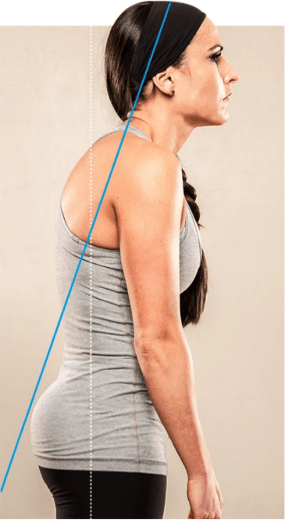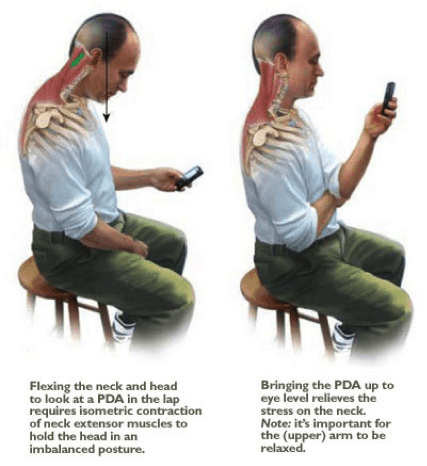
Have you got text neck? I’ve noticed, an increase in incidence of neck pain and/or stiffness in all age groups, but of concern, also in the younger population (10-16 years). I’ve had a look through some research and it appears that “text neck” is on the rise.
It appears that “text neck” is on the rise.
“Text neck” is the term that has been given to a change in cervical (the neck part of your spine) posture and associated neck pain, brought about in part by excessive texting. A study conducted by Dr Kenneth Hansraj, Chief of Spinal Surgery at New York Spine Surgery and Rehabilitation Medicine has assessed the effects of texting on our neck and potential long term problems it may lead to.

Poor posture – neck forward, rounded shoulders is likely to lead to neck pain
The study suggests that good posture as having our ears aligned with our shoulder, and our shoulder blades resting in a retracted (squared) position. This is obviously a generalisation however it is a good enough base line for this study. (Check out the difference – sit or stand up straight and try that posture right now, shoulders back and down – doesn’t that feel better!)
A poor posture, is described as head tilted in a forward position, and the shoulder drooping forward in a rounded position (see the picture). This posture leads to a decrease in the natural curve of the cervical spine, and can incrementally lead to increased stresses on the cervical spine. These stresses may lead to early wear and tear, degeneration, stiffness and neural problems.
Poor posture leads to a decrease in the natural curve of the cervical spine, and increased stressors on the cervical spine. These stressors may lead to early wear and tear, degeneration and stiffness and neural problems.
On average we spend roughly 2-4 hours a day with our heads tilted over, read and texting on smart phones and other hand held devices (kindle, ipads). Cumulatively this is 700 to 1400 hours a year of excess stresses seen on the cervical spine, and in the high school student can be up to an extra 5000 hours a year in a poor posture.
So what does this mean for us? This diagram taken from the study summarises the effect of tilting our heads reading texts and the extra weight going through our spine to do so.
As you can see the greater the forward bending of the neck, the more weight is going through our neck, to convert into Kg in a neutral position our head weighs roughly 5.5kg. As we increase our angle of flexion the weight that our joints, muscles and ligaments have to deal with increases. At 60 degrees of flexion that is more then 5 times the normal forces going through our neck.
So how is this different from reading? It’s not, and as in the past with reading, similar postural related neck pain has been an issue. It’s more about understanding the stresses that we are putting through our neck and trying to adjust and minimise this as much as possible.
How can we do this? Spend less time on the phone! If you do spend a lot of time on hand held devices adjust where you are holding it, similar to computer screens, laptops and books, try and hold your device out in front of you at eye level and minimise the amount of cervical flexion (bend in your neck).
Stretch often, deep neck flexor exercises, upper traps stretches and Mulligan’s stretches are beneficial for postural releated neck pain. They can be done often and will help to “reset” the resting position of your neck.
Don’t ignore the signs. It starts with stifness, can lead to headaches, dizziness, double vision, and eventually can cause pain down the arm. Listen to your body, if you are getting neck pain, have it seen to. One of our talented team will be able to assess your neck, and provide you with advice, strength and stretching exercises, postural aids and bracing and minimise the risk of long term injury.
Jude Holroyd is the Principal Physiotherapist at our Jordan Springs practice. He is working really hard at reducing the amount of time he is spending texting.
